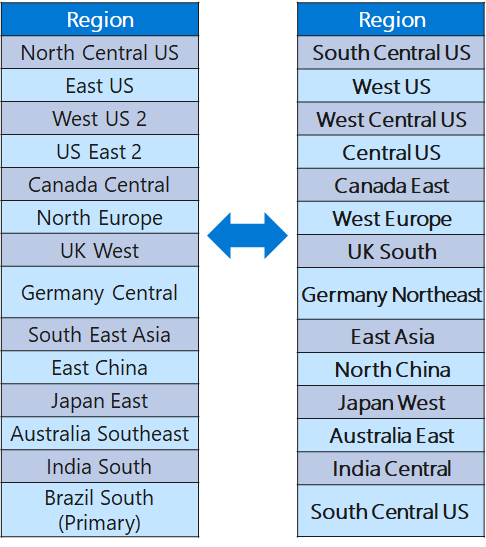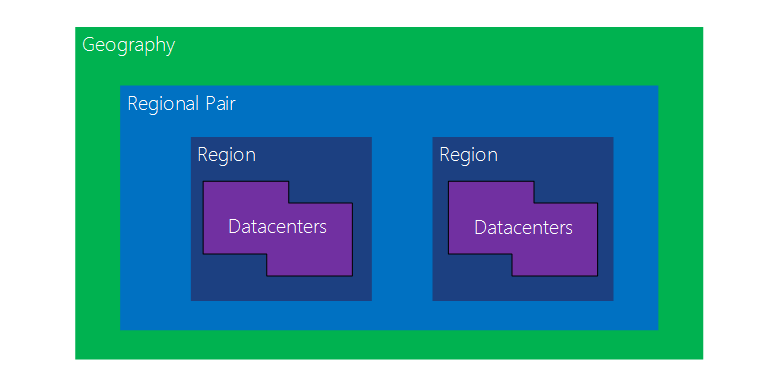Region Pairs - CodeForce2020/AZ-900-Microsoft-Azure-Fundamentals GitHub Wiki
Region Pairs
It's possible that a large enough disaster could cause an outage large enough to affect even two datacenters. That's why Azure creates region pairs. Each Azure region is paired with another region within the same geography (such as US, Europe, or Asia) at least 300 miles away, which together make a region pair . The exception is Brazil South, which is paired with a region outside its geography.

Things to know about regional pairs: Physical isolation. When possible, Azure prefers at least 300 miles of separation between datacenters in a regional pair, although this isn't practical or possible in all geographies. Physical datacenter separation reduces the likelihood of natural disasters, civil unrest, power outages, or physical network outages affecting both regions at once.
Platform-provided replication. Some services such as Geo-Redundant Storage provide automatic replication to the paired region.
Region recovery order. In the event of a broad outage, recovery of one region is prioritized out of every pair. Applications that are deployed across paired regions are guaranteed to have one of the regions recovered with priority.
Sequential updates. Planned Azure system updates are rolled out to paired regions sequentially (not at the same time) to minimize downtime, the effect of bugs, and logical failures in the rare event of a bad update.
Since the pair of regions is directly connected and far enough apart to be isolated from regional disasters, you can use them to provide reliable services and data redundancy. Some services offer automatic geo-redundant storage using region pairs.
Additional advantages of region pairs include:
If there's an extensive Azure outage, one region out of every pair is prioritized to make sure at least one is restored as quick as possible for applications hosted in that region pair. Planned Azure updates are rolled out to paired regions one region at a time to minimize downtime and risk of application outage. Data continues to reside within the same geography as its pair (except for Brazil South) for tax and law enforcement jurisdiction purposes. Having a broadly distributed set of datacenters allows Azure to provide a high guarantee of availability.
Business continuity and disaster recovery (BCDR): Azure Paired Regions
What are paired regions?
An Azure region consists of a set of data centers deployed within a latency-defined perimeter and connected through a dedicated low-latency network. This ensures that Azure services within an Azure region offer the best possible performance and security.
An Azure geography defines an area of the world containing at least one Azure region. Geographies define a discrete market, typically containing two or more regions, that preserve data residency and compliance boundaries. Find more information about Azure's global infrastructure here
A regional pair consists of two regions within the same geography. Azure serializes platform updates (planned maintenance) across regional pairs, ensuring that only one region in each pair updates at a time. If an outage affects multiple regions, at least one region in each pair will be prioritized for recovery.

Some Azure services take further advantage of paired regions to ensure business continuity and to protect against data loss. Azure provides several storage solutions that take advantage of paired regions to ensure data availability.
For example, Azure Geo-redundant Storage (GRS) replicates data to a secondary region automatically, ensuring that data is durable even in the event that the primary region isn't recoverable.
Note that not all Azure services automatically replicate data, nor do all Azure services automatically fall-back from a failed region to its pair. In such cases, recovery and replication must be configured by the customer.
Can I select my regional pairs?
No. Some Azure services rely upon regional pairs, such as Azure's redundant storage. These services don't allow you to create new regional pairings. Similarly, because Azure controls planned maintenance and recovery prioritization for regional pairs, you can't define your own regional pairs to take advantage of these services.
However, you can create your own disaster recovery solution by building services in any number of regions and leveraging Azure services to pair them.
For example, you can use Azure services such as AzCopy to schedule data backups to a Storage account in a different region. Using Azure DNS and Azure Traffic Manager, customers can design a resilient architecture for their applications that will survive the loss of the primary region.
Am I limited to using services within my regional pairs?
No. While a given Azure service may rely upon a regional pair, you can host your other services in any region that satisfies your business needs. An Azure GRS storage solution may pair data in Canada Central with a peer in Canada East while using Compute resources located in East US.
Must I use Azure regional pairs?
No. Customers can leverage Azure services to architect a resilient service without relying on Azure's regional pairs. However, we recommend that you configure business continuity disaster recovery (BCDR) across regional pairs to benefit from isolation and improve availability. For applications that support multiple active regions, we recommend using both regions in a region pair where possible. This ensures optimal availability for applications and minimized recovery time in the event of a disaster. Whenever possible, design your application for maximum resiliency and ease of disaster recovery.
Azure Regional Pairs
| GEOGRAPHY | REGIONAL PAIR A | REGIONAL PAIR B |
|---|---|---|
| Asia - Pacific | East Asia (Hong Kong) | Southeast Asia (Singapore) |
| Australia | Australia East | Australia Southeast |
| Australia | Australia Central | Australia Central 2 |
| Brazil | Brazil South | South Central US |
| Canada | Canada Central | Canada East |
| China | China North | China East |
| China | China North 2 | China East 2 |
| Europe | North Europe (Ireland) | West Europe (Netherlands) |
| France | France Central | France South |
| Germany | Germany Central | Germany Northeast |
| India | Central India | South India |
| India | West India | South India |
| Japan | Japan East | Japan West |
| Korea | Korea Central | Korea South |
| North America | East US | West US |
| North America | East US 2 | Central US |
| North America | North Central US | South Central US |
| North America | West US 2 | West Central US |
| Norway | Norway East | Norway West |
| South Africa | South Africa North | South Africa West |
| Switzerland | Switzerland North | Switzerland West |
| UK | UK West | UK South |
| United Arab Emirates | UAE North | UAE Central |
| US Department of Defense | US DoD East | US DoD Central |
| US Government | US Gov Arizona | US Gov Texas |
| US Government | US Gov Iowa | US Gov Virginia |
| US Government | US Gov Virginia | US Gov Texas |
An example of paired regions
The image below illustrates a hypothetical application that uses the regional pair for disaster recovery. The green numbers highlight the cross-region activities of three Azure services (Azure compute, storage, and database) and how they're configured to replicate across regions. The unique benefits of deploying across paired regions are highlighted by the orange numbers.

Figure 2
Cross-region activities
As referred to in figure 2.
-
Azure Compute (IaaS) – You must provision additional compute resources in advance to ensure resources are available in another region during a disaster. For more information, see Azure resiliency technical guidance.
-
Azure Storage - If you're using managed disks, learn about cross-region backups with Azure Backup, and replicating VMs from one region to another with Azure Site Recovery. If you're using storage accounts, then geo-redundant storage (GRS) is configured by default when an Azure Storage account is created. With GRS, your data is automatically replicated three times within the primary region, and three times in the paired region. For more information, see Azure Storage Redundancy Options.
-
Azure SQL Database – With Azure SQL Database Geo-Replication, you can configure asynchronous replication of transactions to any region in the world; however, we recommend you deploy these resources in a paired region for most disaster recovery scenarios. For more information, see Geo-Replication in Azure SQL Database.
-
Azure Resource Manager - Resource Manager inherently provides logical isolation of components across regions. This means logical failures in one region are less likely to impact another.
Benefits of paired regions
-
Physical Isolation – When possible, Azure prefers at least 300 miles of separation between datacenters in a regional pair, although this isn't practical or possible in all geographies. Physical datacenter separation reduces the likelihood of natural disasters, civil unrest, power outages, or physical network outages affecting both regions at once. Isolation is subject to the constraints within the geography (geography size, power/network infrastructure availability, regulations, etc.).
-
Platform-provided replication - Some services such as Geo-Redundant Storage provide automatic replication to the paired region.
-
Region recovery order – In the event of a broad outage, recovery of one region is prioritized out of every pair. Applications that are deployed across paired regions are guaranteed to have one of the regions recovered with priority. If an application is deployed across regions that are not paired, recovery might be delayed – in the worst case the chosen regions may be the last two to be recovered.
-
Sequential updates – Planned Azure system updates are rolled out to paired regions sequentially (not at the same time) to minimize downtime, the effect of bugs, and logical failures in the rare event of a bad update.
-
Data residency – A region resides within the same geography as its pair (with the exception of Brazil South) to meet data residency requirements for tax and law enforcement jurisdiction purposes.